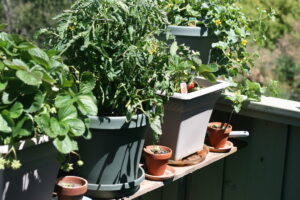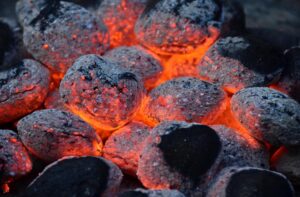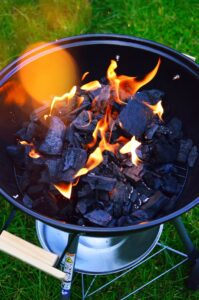
Key Takeaways:
-
Biochar can be used in specially designed stoves to ensure efficient and safe cooking.
-
Biochar is a sustainable cooking fuel that is produced through the pyrolysis of organic matter.
-
Using biochar for cooking can reduce harmful emissions and improve air quality compared to traditional charcoal.
-
It’s essential to follow safety measures when cooking with biochar to prevent any health risks.
-
When used correctly, biochar can contribute positively to the environment.
A Quick Scoop on Biochar and Cooking
Biochar is not a cooking ingredient; it’s a form of charcoal created by burning organic matter in a controlled process called pyrolysis. This process retains the carbon within the material, turning it into a stable form that won’t easily escape into the atmosphere. But, biochar is a type of charcoal and can be used as a cooking fuel. Compared to conventional charcoal, biochar production emits fewer pollutants and preserves more of the natural resources.
Is Biochar in the Kitchen a Good Idea?
Now, you might be thinking, “Can I really use this in my kitchen?” Yes! But there’s a catch. You see, biochar isn’t like flipping on your gas stove or throwing logs into a fireplace. It requires a specific approach to make the most of its benefits. And the benefits are pretty impressive – we’re talking about less smoke and more heat. That’s a win-win in my book.
Understanding Biochar Cooking Safety
But let’s get serious for a moment. Safety is paramount when it comes to cooking with biochar. You’re dealing with high temperatures and potential smoke, so it’s crucial to know the ropes before you light up.
Identifying Potential Risks
Like any form of cooking, using biochar comes with its own set of hazards. The primary concerns are related to the production of carbon monoxide and other harmful emissions if not properly managed. But don’t fret – with the right setup and know-how, these risks can be significantly minimized.
Top Safety Measures to Implement
So, how do we keep things safe? Here are some guidelines:
-
Always use biochar in a well-ventilated area to avoid the buildup of harmful gases.
-
Use a stove designed for biochar to ensure complete combustion and minimal emissions.
-
Never leave your biochar stove unattended while it’s lit – things can get out of hand quickly.
-
Keep a fire extinguisher or water nearby just in case things take a heated turn.
By sticking to these guidelines, you can enjoy the warmth and flavor that biochar brings to your cooking without any worry.
Getting Practical: How to Cook with Biochar
Now, let’s roll up our sleeves and get down to the nitty-gritty. Cooking with biochar isn’t rocket science, but it does require a bit of know-how. Here’s how you can start:
Preparation and Activation of Biochar
Before you can cook with biochar, you’ve got to prepare it. This means ensuring it’s properly activated – a process that increases its surface area and, consequently, its ability to combust efficiently. You can activate biochar by soaking it in water, which also helps to reduce any dust that might affect the taste of your food or the quality of the air.
Once it’s activated, you’ll want to dry the biochar thoroughly. This is crucial because wet biochar won’t burn well, and you’ll end up with a lot of smoke and very little heat. Spread it out in the sun or a dry area until it feels dry to the touch.
Right Tools for the Biochar Cooking Job
When it comes to cooking with biochar, not just any grill or stove will do. You’ll need a setup that’s designed for this unique fuel. Look for stoves that are labeled as ‘biochar-compatible’ or ‘multi-fuel’ – these are built to handle the specific characteristics of biochar, such as its high ash content and the need for controlled airflow.
For grilling, a ceramic grill or a kettle grill with a tight-fitting lid and adjustable vents works wonders. These types of grills allow you to control the oxygen flow, which is key to managing the burn rate of biochar.
Controlling the Heat: A Biochar Cooking Guide
Controlling the heat is where the art of cooking with biochar lies. Start by lighting your biochar in a chimney starter or directly in your grill, allowing it to catch fire and begin to glow. Once it’s lit, you can control the temperature by adjusting the airflow – more air for higher heat, less air to cool things down.
Remember, patience is a virtue with biochar. It might take a little longer to reach the desired temperature compared to conventional fuels, but the wait is worth it for the flavor and environmental benefits.
Final Thoughts: Embracing Biochar Safely
When it comes to cooking with biochar, safety, efficiency, and flavor go hand in hand. With the right approach and tools, you can harness the power of this ancient technique modernized for today’s eco-conscious cook. Remember to use biochar in a well-ventilated area, with equipment specifically designed for its unique properties, and never leave it unattended while in use. Embrace the art of biochar cooking, and join the ranks of those making a difference one meal at a time.
Frequently Asked Questions (FAQ)
Can Biochar Be Used on Any Type of Grill or Stove?
Not quite. Biochar requires specific conditions to burn efficiently and safely. It’s best used in stoves or grills that are designed for it or are labeled as ‘biochar-compatible’ or ‘multi-fuel’. These stoves have features that manage the burn rate and temperature control necessary for using biochar effectively.
What Foods Are Best Cooked with Biochar?
Biochar is particularly great for grilling and smoking, thanks to its ability to impart a rich, smoky flavor. Meats, vegetables, and even pizzas can benefit from the unique taste that biochar provides. However, any food that you would normally cook on a grill or smoker can be cooked with biochar.
How Do You Store Biochar Safely?
Store biochar in a dry, covered area away from any flammable materials. It’s important to keep it dry because wet biochar is difficult to light and doesn’t burn as well. A metal container with a tight lid is ideal to prevent any moisture from getting in and to keep it safely contained.
Are There Any Health Benefits to Cooking with Biochar?
While biochar itself doesn’t have direct health benefits when used for cooking, it does contribute to a healthier environment by reducing pollution. Additionally, cooking with biochar can help to avoid the harmful chemicals that can be released from conventional charcoal or wood fires.



